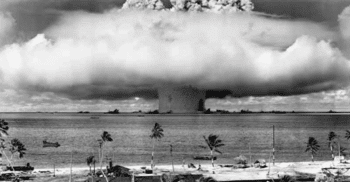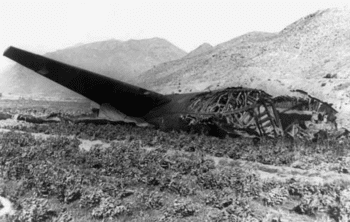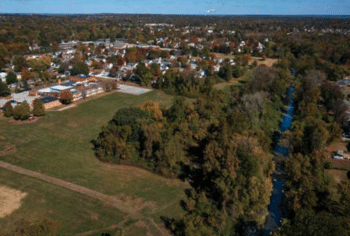Climate crisis could disturb Cold War-era nuclear waste buried by the U.S. decades ago, according to a U.S. federal report.
An ABC News report (Climate change could unearth, disturb Cold War-era nuclear waste buried by the U.S., officials say, Thu, February 29, 2024, abcnews.go.com) said:
Noxious waste buried beneath former nuclear weapons testing sites could be unearthed by 2100 should the greenhouse gas emissions that cause climate change continue at the current rate, a report published by the U.S. Government Accountability Office last month found.
At multiple testing sites around the world, the U.S. military detonated atmospheric nuclear weapons–or hydrogen bombs–and later attempted to clean up the leftover radioactive waste by putting them in containers covered with a concrete cap, Robert Hayes, an associate professor of nuclear engineering at North Carolina State University, told ABC News.
Rising temperatures could cause the spread of the radioactive contamination from these test sites in the coming decades, according to the Government Accountability Office report, which analyzes what is left of the nuclear debris in the Pacific Ocean, Greenland and Spain.
In Greenland, chemical pollutants and radioactive liquid left over from a nuclear power plant at Camp Century, a U.S. military research base, were frozen in ice sheets that could melt in the coming decades, according to the report. Denmark has instituted permanent ice sheet monitoring in the region.

A mushroom-shaped cloud and water column from the underwater Baker nuclear explosion off the Marshall Islands, July 25, 1946. (Pictures from History/Universal Images Group via Getty Images/CounterCurrents)
GREENLANF ICE SHEET
‘The Greenland Ice Sheet is melting faster than previously thought, according to a study published in May 2023. Ice loss in the Arctic is the largest contributor to global sea level rise, scientists say.
MARSHALL ISLANDS
‘In the Marshall Islands, the Runit Dome in the Enewetak Atoll was used as a radioactive waste disposal site that could be disturbed should sea levels continue to rise.
FOR WORLD WAR III
‘The U.S. conducted 67 nuclear weapons tests in the Marshall Islands between 1946 to 1958, according to the Department of Energy. Most of the testing was in preparation for World War III, William Roy, a professor of nuclear, plasma and radiological engineering at the University of Illinois at Urbana-Champaign, told ABC News.
‘There are currently disagreements between Marshall Islands officials and the U.S. Department of Energy on the risk posed by the nuclear waste.’
COMMUNITIES
The ABC News report said:
While the U.S. Department of Energy considers human health risks on the Marshall Islands to be low, Indigenous communities are concerned that climate change could mobilize radiological contamination, posing risks to fresh water and food sources, and local officials believe the U.S. government is downplaying the risks, according to the report.
The authors of the report have recommend that the U.S. Department of Energy come up with a plan to regain the trust of Indigenous communities in the Marshall Islands.

The burnt out wreckage of the B-52 bomber, Jan. 17, 1966, a US B-52 SAC long-range bomber and a tanker plane collided over the Spanish Mediterranean coast near Almeria during a refueling maneuver. (Picture Alliance via Getty Image/Countercurrents)
RUSH UP OF THE COLD WAR
‘The U.S. military believed the cleanup missions they carried out was sufficient at the time but did not account for long-term environmental changes in these regions,” Hayes said.
‘”The military was in the rush of the Cold War,” Hayes said.
In hindsight, they could have done a better job.
SPAIN
The report said:
The site of the 1966 midair collision between two U.S. defense aircraft–of once which was carrying a hydrogen bomb–over the Mediterranean Sea off the coast of Spain exceeded European Union standards for radioactive contamination, according to the report.
But the experts agree that the waste does not pose an immediate threat.
“Should the nuclear waste leak out of the containers, it probably would not cause much damage, as it would dilute drastically in ocean waters,” Hayes said.
“In Greenland, the spent fuel–the material containing the components with the longest half lives–was removed when the reactor was decommissioned, Roy said. The Danish government has also reported that the short-lived radionuclides probably have long-since decayed, according to the report. The remaining nuclides trapped in the ice would probably be diluted by the massive of amount of water creative amid the melting,” Roy said.
In the Marshall Islands, though a more complicated situation with the presence of Plutonium detected, there is likely a “tremendous amount of dilution” there as well, Roy added.
The mere mention of radioactive material tends to spark fear, according to the experts.
”There is generally a public fear that is much higher than the actual risk,” Hayes said.
“Climate change presents problems much more immediate and threatening than Cold War-era nuclear waste,” Roy said.
‘”Probably going to have greater issues from climate change than the mobilization of radionuclides from the Cold War,” he said.’

Containers with high-level radioactive waste stand in interim storage in Lower Saxony, Germany, Dec. 11, 2019. (Photo: Alliance via Getty Images / Countercurrents)
STORING NUCLEAR WASTE
Another ABC News report (Current model for storing nuclear waste may not be sufficiently safe, study says, January 28, 2020) said:
‘The current model the U.S. and other countries plan to use to store high-level nuclear waste may not be as safe as previously thought.
‘The materials used to store the waste “will likely degrade faster than anyone previously knew” because of the way the materials interact, according to research published Tuesday in the journal Nature Materials.
‘The research, funded by the U.S. Department of Energy Office of Science, focused primarily on defense waste, the legacy of past nuclear arms production, which is highly radioactive, according to a press release from Ohio State University. Some of waste has a half-life–the time needed for half the material to decay–of about 30 years. But others, such as plutonium, have a half-life that can be in the tens of thousands of years, according to the release.
‘The plan the U.S. has for the waste is to immobilize long-lived radionuclides–mixed with other materials to form glass or ceramic forms of the waste–in steel canisters and then dispose of them by burying them in a repository deep underground, according to the study. ‘Countries around the globe largely store and dispose of the nuclear waste in a similar fashion.
‘However, scientists found that under simulated conditions, corrosion of the containers could be “significantly accelerated,” which had not been considered in current safety and performance assessment models. The newly formed glass or ceramic compounds, confined in the steel containers, have been observed corroding those containers at surprising rates due to new chemical reactions.’
The report said:
‘The reactions significantly altered both the waste and the metallic canisters, according to the research. Xiaolei Guo, lead author of the study and deputy director of Ohio State University’s Center for Performance and Design of Nuclear Waste Forms and Containers, described the corrosion as “severe.”
‘”In the real-life scenario, the glass or ceramic waste forms would be in close contact with stainless steel canisters. Under specific conditions, the corrosion of stainless steel will go crazy,” he said in a statement. “It creates a super-aggressive environment that can corrode surrounding materials.”
‘The researchers warned that the interaction between the materials, which then impact the service life of the nuclear waste, should be “carefully considered” when evaluating the performance of the waste forms. A more compatible barrier should be selected to optimize the performance of the repository system.
‘”This indicates that the current models may not be sufficient to keep this waste safely stored,” Guo said. “And it shows that we need to develop a new model for storing nuclear waste.”’
It said:
‘The waste is typically stored where it is produced, according to the U.S. Government Accountability Office.
‘The Environmental Protection Agency has proposed that the waste be disposed in a deep geological repository in the Yucca Mountains in Nevada. However, those plans have been stalled since 2009.’

Jana Elementary School, left, which is in the Hazelwood School District, is seen on Oct. 17, 2022, in Fl David Carson/St. Louis Post-Dispatch via AP
A SCHOOL IN THE U.S. AND RADIOACTIVE CONTAMINATION
A Missouri elementary school was to close after report finds radioactive contamination.
Another ABC News report (Missouri elementary school to close after report finds radioactive contamination, October 21, 2022) said:
‘A Missouri elementary school located near a contaminated creek in St. Louis County has closed after a private study found high levels of radioactive waste inside the building and its playground area.
‘The Hazelwood School District announced this week that Jana Elementary School in Florissant will pivot to virtual learning while school officials work on transferring students to different schools in the district in the coming weeks.
‘”The Hazelwood School District Board of Education will be working with our legal counsel to communicate to the appropriate agencies responsible, the necessity to immediately clean up and remediate any and all hazardous waste at Jana Elementary and any other District sites,” the school district said in a statement Wednesday.
‘The closure follows years of requests for testing. The school is located near Coldwater Creek, which was contaminated with uranium and other radioactive waste from a World War II nuclear weapons program, according to the Agency for Toxic Substances and Disease Registry.’
The report said:
‘The school district warned parents in August, weeks before the start of the school year, about potential risks and possible disruptions after U.S. Army Corps of Engineer testing found radioactive contamination on the banks of the creek, at the edge of the school’s property.
‘The latest findings, from Boston Chemical Data Corp., have sparked calls for cleanup from parents and officials and concerns about potential exposure, while families also figure out next steps.’
CREEK’S HISTORY OF CONTAMINATION
The report said:
‘Coldwater Creek, a 19-mile tributary of the Missouri River, passes near sites that were used in the development of nuclear weapons for the Manhattan Project, including radioactive waste storage piles.
‘The creek is contaminated with “uranium processing residues” that were improperly stored near it, according to the Agency for Toxic Substances and Disease Registry, which in 2019 released a public health assessment report that found an increased risk of certain cancers for residents who “regularly played or lived along the creek for many years in the past.”
‘Jana Elementary sits on the flood plain of Coldwater Creek. The Corps, which is charged with the creek’s remediation, first detected radioactive contaminants near the school in 2018 and again in 2019, 2020 and 2021, according to the Boston Chemical Data Corp. report.
‘Following the latest testing, the Corps notified school officials in January that soil sampling conducted on the school’s property “showed the presence of low-level radioactive contamination” on the banks of Coldwater Creek, the Hazelwood School District said in an Aug. 5 letter to the school community.
‘”They further informed the district that the contamination did not pose an immediate risk to human health or the environment because the contamination was below ground surface,” the letter stated.
‘The school district gave parents the option for virtual learning while it awaited the results of further testing.’
LATEST TESTING SPARKS CLOSURE
The report said:
‘The decision to close the school comes a week after the release of the Boston Chemical Data Corp. report, which found radioactive waste in the school and its playground. The report was funded by law firms involved in a class action lawsuit alleging illnesses and deaths caused by the creek contamination.
‘The school district granted the request for the testing, which was conducted in August, according to the Jana Elementary PTA, which alerted families to the report’s findings on Oct. 14.
‘Testing of dust and soil samples indicated high levels of radioactive lead in the school, including the library, and playground, according to the report. The levels in the kindergarten play area were “22 times the expected background,” according to the report.
‘”The most outstanding result of August 2022 testing at the Jana School was that levels of the radioactive isotope lead-210 found on school grounds were entirely unacceptable,” the report stated.
‘The Corps has not corroborated the findings of the private report.
‘In a statement Tuesday, the Corps’ Formerly Utilized Sites Remedial Action Program for the St. Louis District said the school property has contamination that is “isolated” to the creek bank, and that sample locations in the floodplain between the bank and playground area “aren’t contaminated.”
‘”The team will evaluate the report that Boston Chemical Data Corp. compiled on Jana Elementary School and the methods used to create these results,” it said in a news release.
That report isn’t consistent with FUSRAP’s accepted evaluation techniques and must be thoroughly vetted to ensure accuracy.
CALLS FOR CLEANUP, ANSWERS
The report said:
‘Missouri Sen. Josh Hawley has called on the Corps to review the findings of the independent report, conduct further testing on the school grounds and publicly report their findings.
‘”It should go without saying that hazardous, radioactive contamination has no place in schools, or anywhere near schools, or anywhere near any place where children are. And it should also go without saying the federal government must be honest and transparent about the facts,” Hawley wrote in a letter to Corps Lt. Gen. Scott Spellmon on Tuesday.
‘The senator has also urged President Joe Biden to declare a federal emergency and authorize “immediate relief” for all impacted families and to expedite the cleanup.
‘Missouri Rep. Cori Bush has also demanded an “urgent response” to the emergency.
‘”The federal government is responsible for this waste, and we need answers from them on their plan to immediately begin cleanup of Jana Elementary and the surrounding areas so our kids’ health and education is not further disrupted by the presence of toxic chemicals,” she said in a statement earlier this week.
Inaction is not an option. The safety of our children and our communities must come first.
The Missouri Coalition for the Environment has called on the school district to “act swiftly to secure a comprehensive cleanup of all radioactive bomb waste at the school.”
‘”In the interim, they must provide parents with options to continue students’ education with minimal disruption,” the group said.
We are approaching 80 years since this nuclear bomb waste has been allowed to plague our neighborhoods.

